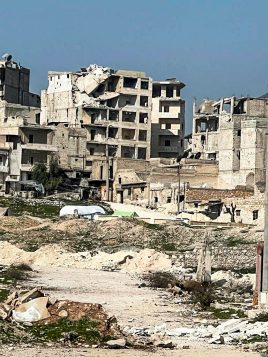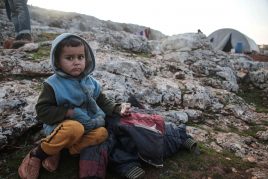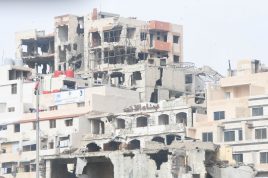
Following the Israeli attacks, an estimated 80,000 to 105,000 people – Syrians and Lebanese – have fled Lebanon. These are figures released by the Syrian authorities. “It’s a complex situation – Davide Chiarot, a Caritas Italy worker in Syria, told SIR – and it’s hard to get a clear picture of the situation on the ground.” These numbers are higher than those reported a few days ago by the UN High Commissioner for Refugees, Filippo Grandi, who, via social media, reported “50,000 Lebanese and Syrian nationals residing in Lebanon who crossed into Syria to flee Israeli air strikes.” He referred to the “rescue operations, including by UNHCR, the UN refugee agency, in coordination with the Lebanese and Syrian governments, to help all those in need.”
 According to the Lebanese authorities, more than 1.5 million Syrians sought refuge in the Land of the Cedars during the war in Syria that broke out in 2011.
According to the Lebanese authorities, more than 1.5 million Syrians sought refuge in the Land of the Cedars during the war in Syria that broke out in 2011.
Since Israel’s attack on Hezbollah, however, the situation has reversed. It is the Lebanese who are crossing the border into Syria, which remains unstable and under the control of President Bashar al-Assad.
According to UNHCR, Syrian authorities “are allowing Lebanese nationals to enter Syria for an unspecified period of time, on condition that they provide proof of identity.”
Monitored border crossings. Syrian nationals face greater difficulties because, as Chiarot explains, “many of those who fled the country were political opponents of Bashar al-Assad. For these people, re-entering the country could be dangerous. There are fewer problems for those with relatives and friends and therefore a place to stay in Syria. We also know that in some areas of northern Syria outside government control, arrangements are being made for the safe arrival of displaced people.
As for us, we are awaiting news from Caritas Syria concerning the border crossing near Damascus, which they are monitoring, in order to assess the needs and possible humanitarian responses for the incoming displaced persons,” the Caritas worker added.
At the moment, the Red Crescent and the Syrian government operate separately. “A major controversy has also arisen because Syrians normally have to exchange $100 at the border at the official exchange rate when returning to Syria from abroad,” says Chiarot. “But given the emergency situation, many people do not have this money and are stranded at the border. There is no such issue for Lebanese refugees, who have more money despite their country’s financial crisis. Last Sunday, the government suspended this obligation for one week”.
 Bus terminals crammed with displaced people. “Bus terminals in Homs, where Caritas is operating, are now crammed with stranded displaced people, most of them families with children, awaiting someone who will give them a lift that will enable them to reach their friends and relatives,” Chiarot said. “These people cannot afford taxis or private transport.” In this context, Caritas Italy, in collaboration with Caritas Syria, is studying the possibility of assisting the displaced people at the bus terminals by providing them with basic necessities, blankets and warm clothes. The shortage of diesel and petrol, which used to be smuggled in from Lebanon, has further worsened mobility problems. “This supply has diminished considerably due to the tensions in Lebanon,” says the Caritas Italy worker, “with serious consequences for mobility. Without fuel, there is no means of transport. Another problem that is likely to emerge soon is the increase in rental prices for displaced people arriving into Syria.” What is interesting, Chiarot points out: “is the decision by the Syrian Ministry of Education to allow Syrian and Lebanese children displaced in Syria to attend school, at least in kindergartens.”
Bus terminals crammed with displaced people. “Bus terminals in Homs, where Caritas is operating, are now crammed with stranded displaced people, most of them families with children, awaiting someone who will give them a lift that will enable them to reach their friends and relatives,” Chiarot said. “These people cannot afford taxis or private transport.” In this context, Caritas Italy, in collaboration with Caritas Syria, is studying the possibility of assisting the displaced people at the bus terminals by providing them with basic necessities, blankets and warm clothes. The shortage of diesel and petrol, which used to be smuggled in from Lebanon, has further worsened mobility problems. “This supply has diminished considerably due to the tensions in Lebanon,” says the Caritas Italy worker, “with serious consequences for mobility. Without fuel, there is no means of transport. Another problem that is likely to emerge soon is the increase in rental prices for displaced people arriving into Syria.” What is interesting, Chiarot points out: “is the decision by the Syrian Ministry of Education to allow Syrian and Lebanese children displaced in Syria to attend school, at least in kindergartens.”
 The support of Caritas Italy. Caritas Italy is continuing its project of support, accompaniment and training while waiting to define the aid packages that it will provide to Caritas Syria for this new emergency. “There are several priority areas”, says Chiarot. “The most important is health. We finance and support projects aimed at providing medical care and access to medical services for the most vulnerable. We are also involved in reconstruction efforts following the February 2023 earthquake in Syria. After the emergency and the provision of immediate relief, we are now reorganising a number of vocational training projects in the worst-hit areas of Aleppo and Latakia, with the aim of establishing small income-generating activities. Another area of particular concern for Caritas Italy is peace and reconciliation, with a focus on young people. “A few years ago, we established a Christian-Muslim youth centre in Damascus,” said Chiarot. “We are exploring with Caritas Syria the possibility of extending this experience to other cities. Together with Caritas staff, we are also developing training programmes on conflict mediation, peace and reconciliation. Caritas Italy’s activities in Syria include support for local Christian pastoral activities. This is where Caritas Syria can help build on the good practices already in place elsewhere.” Indeed, says Chiarot, “Caritas Syria can leverage its networks not only to seek funding, but also to assist in project development. This will bring Caritas closer to the local communities and encourage the animation of charitable efforts.”
The support of Caritas Italy. Caritas Italy is continuing its project of support, accompaniment and training while waiting to define the aid packages that it will provide to Caritas Syria for this new emergency. “There are several priority areas”, says Chiarot. “The most important is health. We finance and support projects aimed at providing medical care and access to medical services for the most vulnerable. We are also involved in reconstruction efforts following the February 2023 earthquake in Syria. After the emergency and the provision of immediate relief, we are now reorganising a number of vocational training projects in the worst-hit areas of Aleppo and Latakia, with the aim of establishing small income-generating activities. Another area of particular concern for Caritas Italy is peace and reconciliation, with a focus on young people. “A few years ago, we established a Christian-Muslim youth centre in Damascus,” said Chiarot. “We are exploring with Caritas Syria the possibility of extending this experience to other cities. Together with Caritas staff, we are also developing training programmes on conflict mediation, peace and reconciliation. Caritas Italy’s activities in Syria include support for local Christian pastoral activities. This is where Caritas Syria can help build on the good practices already in place elsewhere.” Indeed, says Chiarot, “Caritas Syria can leverage its networks not only to seek funding, but also to assist in project development. This will bring Caritas closer to the local communities and encourage the animation of charitable efforts.”











